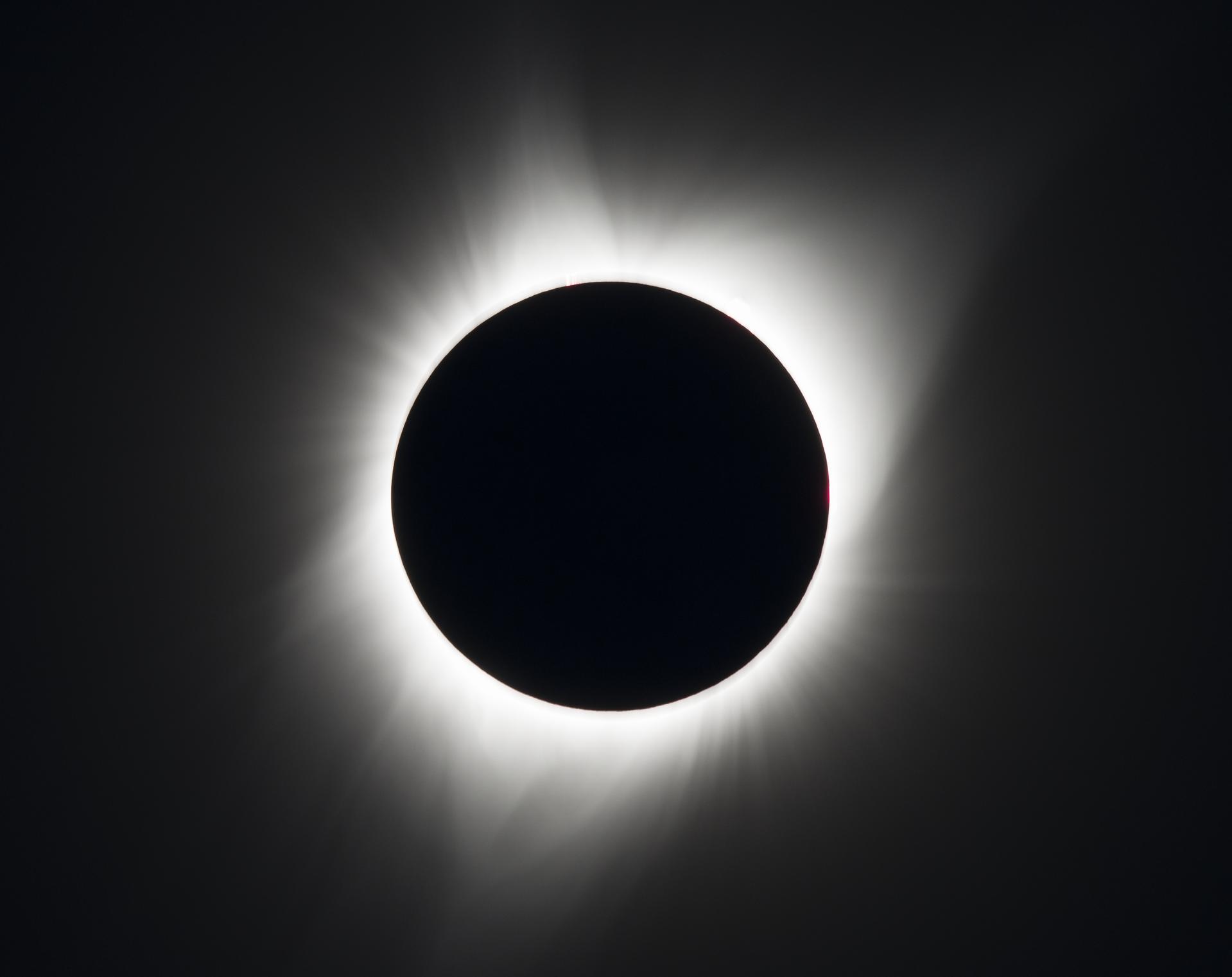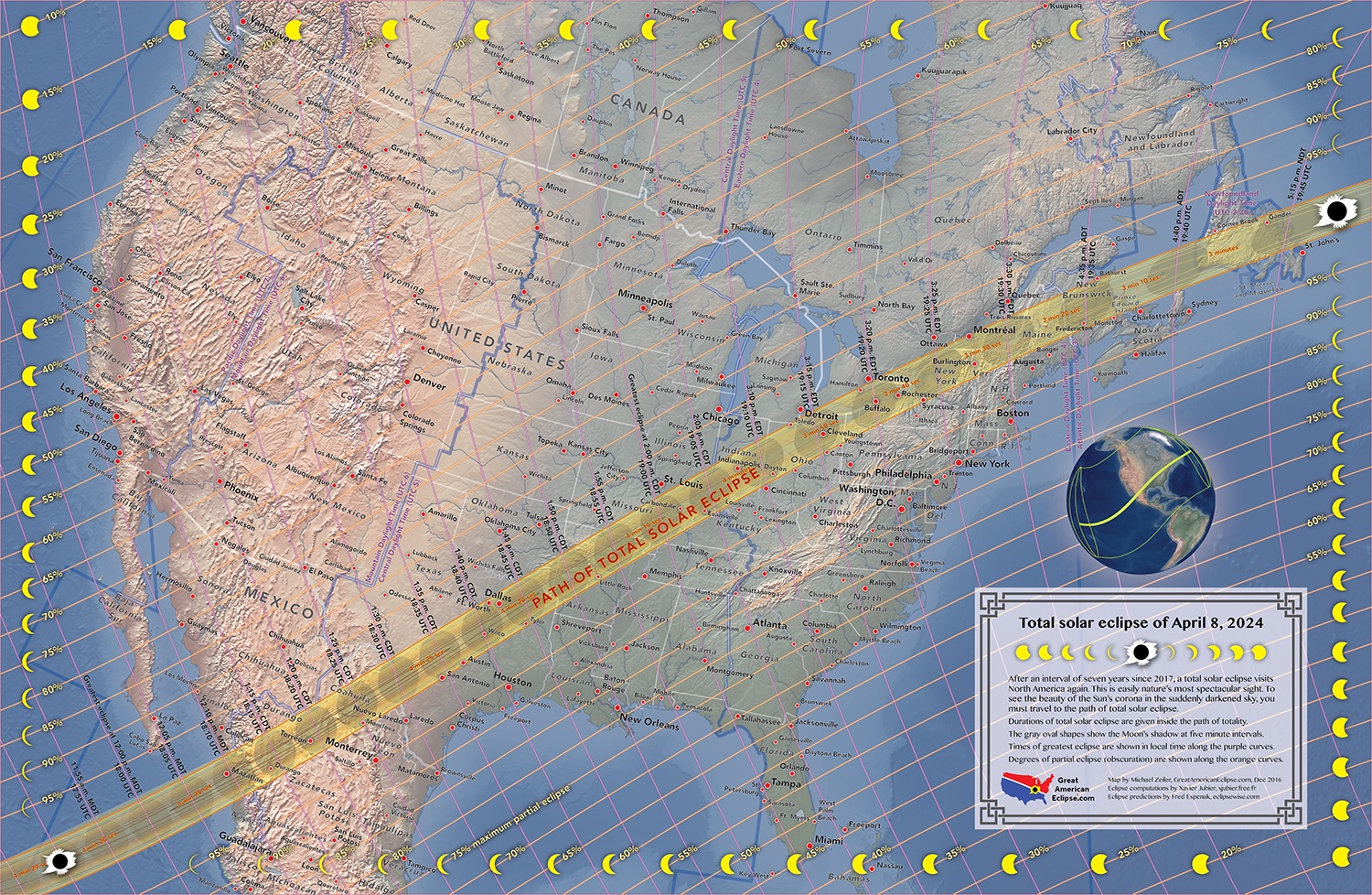
Three years from today, on Monday, April 8, 2024, more than half a billion people across North America will likely take a few moments out of their daily routines, and gaze up into the sky to get a view of one of nature's great shows: an eclipse of the sun.
And those who are fortunate to be positioned along a narrow path stretching across northern Mexico through parts of 15 U.S. states, there will come the opportunity to what many have come to call the most spectacular of celestial roadshows — a total solar eclipse.
Many readers certainly will remember "The Great American Eclipse of 2017." That event received considerable media attention and rightly so. It was the first total eclipse of the sun to be visible from the contiguous (48) United States since 1979, the first since 1918 to go from coast-to-coast and the first total solar eclipse to be visible from the United States in the 21st century. And it was also the very first time in modern history that the path of totality was visible solely from within the confines of the United States and no other country.
Video: Total Solar Eclipse in April 2024 - See the path of totality
Related: Total solar eclipse 2024: Here's what you need to know
A solar eclipse spectacle
It was an amazing experience for all who saw the sky suddenly darken to mid-twilight levels and with it, the sudden appearance of stars and planets in what only moments earlier was a daytime sky.
Then of course, there was the incredible corona, the outer atmosphere of the sun, visible only during those precious moments when the disk of the sun is completely obscured by the moon. And in a few places around the moon's dark limb, prominences — pinkish tongues of glowing hydrogen gas — were also evident. And as the first rays of emerging sunlight streaked past the rugged rough edge of the moon, a "diamond ring" was briefly created, signaling an abrupt end to "The Greatest Show on Earth."
But the best is yet to come. For as spectacular as "The Great American Eclipse of 2017" was, an even better eclipse is on its way in 2024.
Get the Space.com Newsletter
Breaking space news, the latest updates on rocket launches, skywatching events and more!
"The Great North American Solar Eclipse," which will start in Mexico, cross into Texas, then heads northeast into the Ohio River Valley, upstate New York, Quebec, Canada and New England, finally exiting the continent through the Canadian Maritimes. And it's not too early to start making plans to see it!
Related: The Most Amazing Photos of the 2017 Total Solar Eclipse
A standout among total eclipses

Since the signing of the Declaration of Independence, the dark shadow cone of the moon — called the umbra — from where the spectacle of a total eclipse can be viewed, has swept across parts of the lower 48 states only 21 times. The duration of totality for these eclipses has ranged from just one second (April 28, 1930) to an incredibly long 5 minutes and 20 seconds (June 24, 1778). The average duration of totality for all twenty-one cases comes out to be 2 minutes 12 seconds.
For the eclipse of August 21, 2017, the maximum duration of totality lasted 2 minutes 40 seconds, which was nearly a half minute longer than the US average.
But on April 8, 2024, the maximum duration of totality will last as long as 4 minutes and 26 seconds (over southwest Texas). That's 135 seconds longer than the US average and 40 percent longer than the maximum duration of the 2017 eclipse.
Related: The greatest solar eclipses in U.S. history
In fact, of the 21 previous totalities that have swept across the current contiguous US boundaries, only two surpass the 2024 eclipse in terms of duration of totality: the aforementioned eclipse of 1778 and the eclipse of June 16, 1806 (4 minutes 52 seconds). This latter eclipse is famous for the observations made by José Joaquín de Ferrer, a Spanish astronomer who was the first to coin the term corona" for the halo of light that surrounds the darkened sun during totality, and by James Fenimore Cooper, who recounted his own experience witnessing this eclipse from Cooperstown, New York in an autobiographical vignette.
The width of the totality path of the 2024 eclipse will also be exceptional: The shadow path for the previous 21 U.S. eclipses averaged about 93 miles (150 kilometers) wide. In 2017, it was about 71 miles (115 km) wide, but in 2024 the path of totality will be considerably larger, measuring 124 miles (200 km) across.
A big audience!
Usually, the path of most total solar eclipses tends to have a perverse habit in sweeping over remote parts of the Earth or over wide stretches of ocean, and avoiding large population centers. Not so in 2024.
In Mexico, the cities of Mazatlán (population 503,000), Durango (pop. 655,000) and Torreon (pop. 735,000) are within the totality path. In the United States, the largest population center will be Dallas, Texas (pop. 1.3 million), followed by Austin (pop. 951,000), Indianapolis, Indiana (pop. 864,000), Cleveland, Ohio (pop. 385,000), Buffalo, New York (pop. 256,000) and Rochester (pop. 207,000).
And there are many other big cities such as San Antonio, Texas, St. Louis, Missouri, Louisville, Kentucky, Cincinnati and Columbus in Ohio, and Pittsburgh, Pennsylvania that are less than a few hours' drive from the zone of totality.
The largest city that will witness the total eclipse will be in Canada: Montreal, Quebec, (pop. 1.8 million).
Interestingly, over the lower Ohio Valley, the totality paths of the 2017 and 2024 intersect. On average, a specific geographic location is treated to a total solar eclipse approximately once every 375 years. But Carbondale, Illinois — which has christened itself as the "Eclipse Crossroads" city — will again experience totality in 2024, less than 7 years after having experienced the total eclipse of 2017!
Weather prospects
According to Canadian meteorologist Jay Anderson, who has spent many years researching the climatological conditions in advance of upcoming solar eclipses: "April is a month of transition across the continent, with winter storms gradually giving way to the convective buildups of spring and summer. In Mexico, the winter dry season is in its last month before the summer rains begin. Over the United States, southern parts of the track are already well into the thunderstorm season, while to the north, spring storms and occasional snowfalls still hint of the departing winter. In Maritime Canada, the last of the winter snow has yet to melt and fresh snowfalls are a threat with every weather system."
The best probabilities of good weather are in Mexico, where cloud coverage ranges anywhere from only around 20%, increasing to right around 50% at the Texas border. In contrast to these conditions, the weather outlook across the United States is marginal, if not downright unfavorable. Climatological records indicate that average cloud cover increases from roughly 50- 60% in Texas, northeast to the Missouri-Illinois border, then jumps to nearly 80 percent at the Indiana-Ohio border. Near and along the Great Lakes, cloud cover drops back to around 60-65%, before again rising above 80% for Quebec, northern New England and the Maritimes. You can get more details at the Eclipsophile website here.
But even in the most pessimistic regions, one need only remember the famous aphorism attributed to science fiction writer, Robert Heinlein: "Climate is what you expect, but weather is what you get!"
Indeed, April weather in the United States and southern Canada is much more variable than in Mexico, so that at any location there is some hope of very clear skies on eclipse day.
And as we get closer to that special day, Space.com will provide detailed coverage for prospective eclipse chasers, so mark your calendars and stay tuned!
Joe Rao serves as an instructor and guest lecturer at New York's Hayden Planetarium. He writes about astronomy for Natural History magazine, the Farmers' Almanac and other publications. Follow us on Twitter @Spacedotcom and on Facebook.
Join our Space Forums to keep talking space on the latest missions, night sky and more! And if you have a news tip, correction or comment, let us know at: community@space.com.

Joe Rao is Space.com's skywatching columnist, as well as a veteran meteorologist and eclipse chaser who also serves as an instructor and guest lecturer at New York's Hayden Planetarium. He writes about astronomy for Natural History magazine, Sky & Telescope and other publications. Joe is an 8-time Emmy-nominated meteorologist who served the Putnam Valley region of New York for over 21 years. You can find him on Twitter and YouTube tracking lunar and solar eclipses, meteor showers and more. To find out Joe's latest project, visit him on Twitter.









